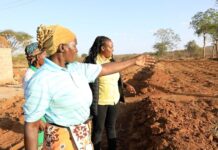Land Reform – Efforts to redress the dispossession of black people of their land by centuries of colonialism and decades of apartheid have yielded limited progress 28 years into democracy despite the introduction of a raft of policy changes and amendments to the legal framework governing land reform, says Peter Setou, Chief Executive of the Vumelana Advisory Fund, a non-profit organisation that helps beneficiaries of the land reform programme to put their land to profitable use by establishing commercially viable partnerships between communities and investors.
In the Oxford Handbook of the South African Economy, agricultural and business scholars, Wandile Sihlobo and Professor Johann Kirsten estimate that, of the 77,580 million hectares of farmland owned by white farmers, a total of 13.2 million hectares (or 17 per cent) has already been transferred away from white landowners to the State (3.08 million ha) or Black owners (10.135 million ha) through private and State-supported transactions, including land restitution (Vink and Kirsten 2019).
“If we add the hectares of land (2.339 million ha) that were successfully identified for restitution but for which communities elected to receive financial compensation as the means for restitution, then the total area of land rights that were restored since 1994 is 15.56 million ha. This is equivalent to 20 per cent of formerly white-owned land, which is much closer to the 30 per cent target (of 23.25 million ha) than commonly believed,” reads the report.
“Equity and equality remain the founding principles of our freedom, and if we are to uphold these, there is a need to actively involve private players in partnership with government and non-government organisations and beneficiaries of land reform to find solutions and further ensure maximum use of the acquired land,” says Setou.
Setou acknowledges the interventions that the government has made to speed up the land reform programme, however, points out that many of them have failed to yield the expected results.
“The willing seller-willing buyer principle takes too long to negotiate and mediation in the claims process is lengthy, and these, coupled with limited institutional capacity to resolve land restitution claims, aggravate the situation. Several challenges remain around resettlement support to new landowners, and the unavailability of monitoring systems to keep track of progress post-settlement does not help matters either. We need to move with urgency to provide the necessary support needed by land reform beneficiaries for them to realise the benefits of their land,” Setou adds.
The government has invested more than R60 billion into land reform projects since 1994, yet the land reform programme has not stimulated development in the targeted rural areas. The government’s Financial and Fiscal Communication itself admits that land reform as a mechanism for agricultural development and job creation has failed, with most of the farms showing little or no agricultural activity. A government survey carried out in provinces that include Limpopo and KwaZulu-Natal also shows that most of the land reform beneficiaries earn little to no income and most of them seek work on surrounding commercial farms instead of actively farming their own land.
Vumelana Advisory Fund agrees with the sentiments expressed by co-writers, Wandile Sihlobo and Professor Johann Kirsten, who opine that the recently formed Land Reform and Agricultural Development Agency, has the potential to speed up land reform.
Both Sihlobo and Kirsten advise that the model could be the vehicle through which farmland can be returned to the majority of South Africans, with three notable differences from previous efforts. Firstly, it would ensure that beneficiaries weren’t being set up to fail, as has been the case in the past. Secondly, commercial farmers, who benefited from the past injustices, would have an opportunity – in a non-politicised way and with little red tape – to contribute meaningfully to land reform. Three, it will happen at the local level where local context and knowledge will drive the process.
Both Sihlobo and Kirsten argue that the agency would bring about national coordination, reduce red tape, and become a one-stop-shop for issues related to a decentralised redistribution of agricultural land. In addition, this would not require excessive fiscal outlays but would use existing sources of material and other forms of support from the commercial agricultural sector. Equally, land donations and a recognition for these donations will also be the key mechanism to fast track land reform.
Vumelana is of the view that the private sector working in collaboration with the government and other stakeholders in the land reform space have an important role to play to ensure the success of the land reform programme. Since Vumelana was established 10 years ago, the organisation has successfully supported over 23 beneficiary community projects in land reform, facilitating partnerships between communities and private investors, attracting investments of nearly R1 billion for communities, and putting over 70 000 hectares of land to profitable use, with the potential to create or save in excess of 2 300 jobs.
“As we commemorate Freedom Day and what it really means to South Africans, it is also instructive to revisit and implement the recommendations made by the High-Level Panel chaired by former president Kgalema Motlanthe. We cannot move forward if those bottlenecks that the Panel identified are not adequately addressed and sufficiently dealt with. Ignoring the challenges that the Panel identified will not get rid of them. On the contrary, they will linger on and frustrate any future efforts at implementing a land reform programme,” Setou concludes.









